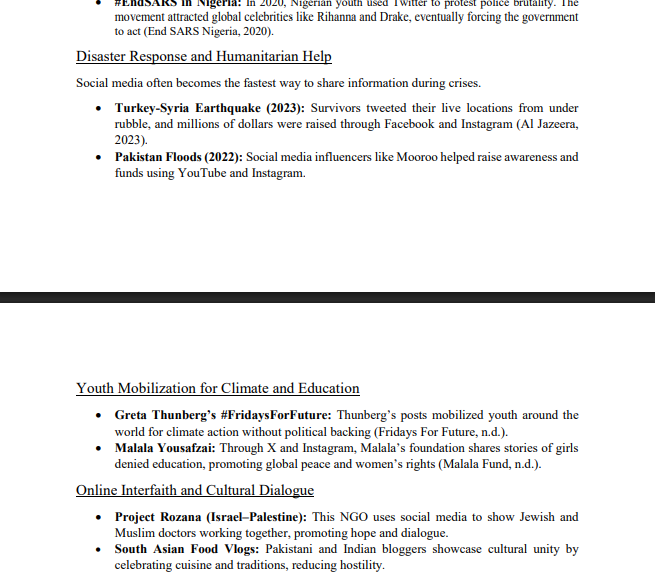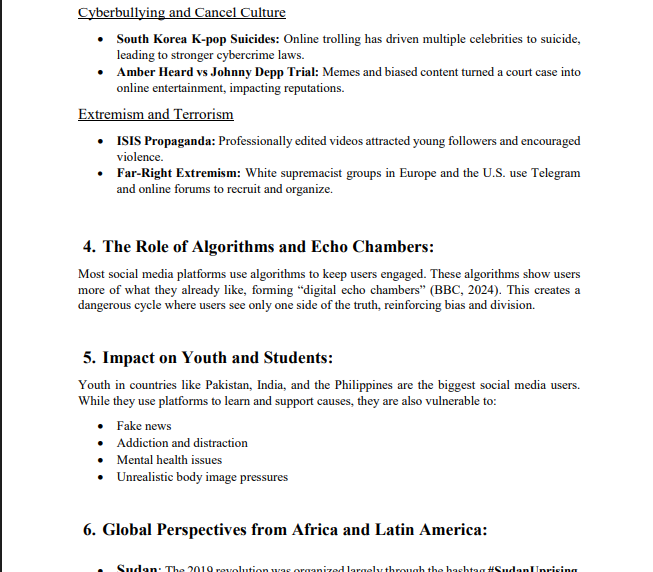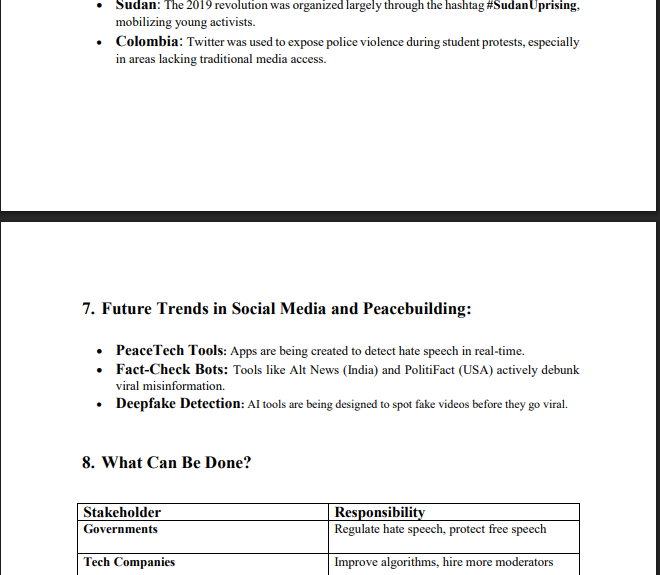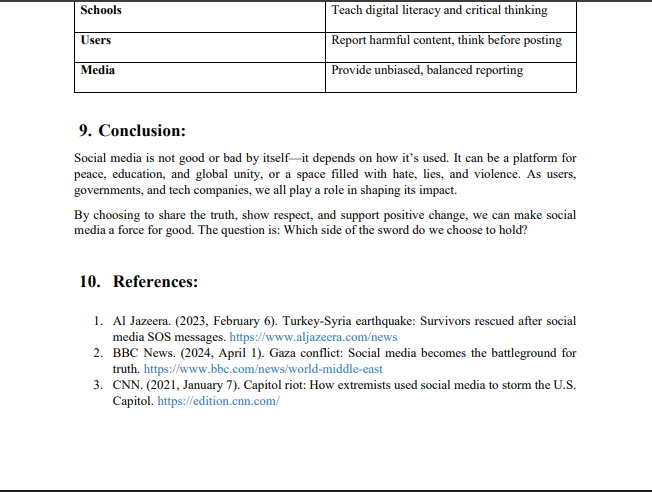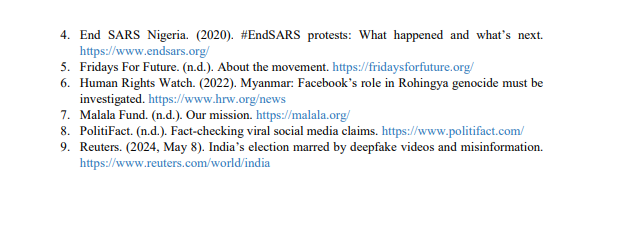1.Introduction:
Social media is one of the most powerful tools in the modern world. Every day, billions of people use platforms like Facebook, Instagram, YouTube, TikTok, and X (formerly Twitter) to connect, communicate, and express themselves. But social media is not just about fun or entertainment—it is also shaping our world socially, politically, and emotionally (Al Jazeera, 2023).
It helps people speak out, organize peaceful protests, raise awareness, and support each other in times of need. At the same time, it spreads misinformation, hate speech, online bullying, and even violence. Social media is a double-edged sword—a tool that can be used both for peace and conflict. This paper explores both sides of its impact and presents real-world examples along with practical solutions for reducing harm.
2.Social Media as a Tool for Peace:
Spreading Peaceful Messages and Raising Awareness
Social media is widely used to promote peaceful campaigns and global awareness.
• #FreePalestine Movement: During the 2023–2024 Gaza conflict, videos and posts from Palestinian civilians reached global audiences via TikTok and Instagram. Many international users supported the cause through donations and awareness campaigns (BBC News, 2024).
• #EndSARS in Nigeria: In 2020, Nigerian youth used Twitter to protest police brutality. The movement attracted global celebrities like Rihanna and Drake, eventually forcing the government to act (End SARS Nigeria, 2020).
Disaster Response and Humanitarian Help
Social media often becomes the fastest way to share information during crises.
• Turkey-Syria Earthquake (2023): Survivors tweeted their live locations from under rubble, and millions of dollars were raised through Facebook and Instagram (Al Jazeera, 2023).
• Pakistan Floods (2022): Social media influencers like Mooroo helped raise awareness and funds using YouTube and Instagram.
Youth Mobilization for Climate and Education
• Greta Thunberg’s #FridaysForFuture: Thunberg’s posts mobilized youth around the world for climate action without political backing (Fridays For Future, n.d.).
• Malala Yousafzai: Through X and Instagram, Malala’s foundation shares stories of girls denied education, promoting global peace and women’s rights (Malala Fund, n.d.).
Online Interfaith and Cultural Dialogue
• Project Rozana (Israel–Palestine): This NGO uses social media to show Jewish and Muslim doctors working together, promoting hope and dialogue.
• South Asian Food Vlogs: Pakistani and Indian bloggers showcase cultural unity by celebrating cuisine and traditions, reducing hostility.
Mental Health Advocacy and Support
• Hashtags like #ItsOkayNotToBeOkay and content by TikTok therapists help youth cope with mental health challenges, especially during COVID-19 lockdowns.
3.Social Media as a Tool for Conflict:
Misinformation and Conspiracy Theories
Lies often go viral faster than truth.
• COVID-19 Vaccines: Platforms like WhatsApp were flooded with fake claims about vaccines containing tracking chips, increasing vaccine hesitancy (CNN, 2021).
• Indian Elections (2024): Deepfake videos falsely portrayed politicians saying things they never said, confusing voters and creating distrust (Reuters, 2024).
Hate Speech and Online Violence
• Islamophobia in France: Hashtags like #BanIslam circulated on X after violent events, worsening religious division.
• Rohingya Crisis (Myanmar): Facebook was used to spread hate against Rohingya Muslims, contributing to ethnic violence (Human Rights Watch, 2022).
Political Polarization
• Capitol Hill Riot (2021): Social media groups helped organize the attack based on election conspiracy theories (CNN, 2021).
• Pakistan’s Political Divide: TikTok and YouTube are used by political parties like PTI, PML-N, and PPP to manipulate followers and deepen divides.
Cyberbullying and Cancel Culture
• South Korea K-pop Suicides: Online trolling has driven multiple celebrities to suicide, leading to stronger cybercrime laws.
• Amber Heard vs Johnny Depp Trial: Memes and biased content turned a court case into online entertainment, impacting reputations.
Extremism and Terrorism
• ISIS Propaganda: Professionally edited videos attracted young followers and encouraged violence.
• Far-Right Extremism: White supremacist groups in Europe and the U.S. use Telegram and online forums to recruit and organize.
4.The Role of Algorithms and Echo Chambers:
Most social media platforms use algorithms to keep users engaged. These algorithms show users more of what they already like, forming “digital echo chambers” (BBC, 2024). This creates a dangerous cycle where users see only one side of the truth, reinforcing bias and division.
5.Impact on Youth and Students:
Youth in countries like Pakistan, India, and the Philippines are the biggest social media users. While they use platforms to learn and support causes, they are also vulnerable to:
• Fake news
• Addiction and distraction
• Mental health issues
• Unrealistic body image pressures
6.Global Perspectives from Africa and Latin America:
• Sudan: The 2019 revolution was organized largely through the hashtag #SudanUprising, mobilizing young activists.
• Colombia: Twitter was used to expose police violence during student protests, especially in areas lacking traditional media access.
7.Future Trends in Social Media and Peacebuilding:
• PeaceTech Tools: Apps are being created to detect hate speech in real-time.
• Fact-Check Bots: Tools like Alt News (India) and PolitiFact (USA) actively debunk viral misinformation.
• Deepfake Detection: AI tools are being designed to spot fake videos before they go viral.
8.What Can Be Done?
Stakeholder Responsibility
Governments Regulate hate speech, protect free speech
Tech Companies Improve algorithms, hire more moderators
Schools Teach digital literacy and critical thinking
Users Report harmful content, think before posting
Media Provide unbiased, balanced reporting
9.Conclusion:
Social media is not good or bad by itself—it depends on how it’s used. It can be a platform for peace, education, and global unity, or a space filled with hate, lies, and violence. As users, governments, and tech companies, we all play a role in shaping its impact.
By choosing to share the truth, show respect, and support positive change, we can make social media a force for good. The question is: Which side of the sword do we choose to hold?
10.References:
1. Al Jazeera. (2023, February 6). Turkey-Syria earthquake: Survivors rescued after social media SOS messages. https://www.aljazeera.com/news
2. BBC News. (2024, April 1). Gaza conflict: Social media becomes the battleground for truth. https://www.bbc.com/news/world-middle-east
3. CNN. (2021, January 7). Capitol riot: How extremists used social media to storm the U.S. Capitol. https://edition.cnn.com/
4. End SARS Nigeria. (2020). #EndSARS protests: What happened and what’s next. https://www.endsars.org/
5. Fridays For Future. (n.d.). About the movement. https://fridaysforfuture.org/
6. Human Rights Watch. (2022). Myanmar: Facebook’s role in Rohingya genocide must be investigated. https://www.hrw.org/news
7. Malala Fund. (n.d.). Our mission. https://malala.org/
8. PolitiFact. (n.d.). Fact-checking viral social media claims. https://www.politifact.com/
9. Reuters. (2024, May 8). India’s election marred by deepfake videos and misinformation. https://www.reuters.com/world/india


